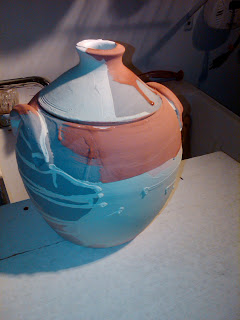Over last weekend I began a test fire of the kiln. It reached around 800 degrees and I decided that I would shut it down because of a running concern I've had for the radiant tubing in the concrete floor. The floor was warm, not hot but I expect repeated ramping to over 2000 deg. F could have a negative effect on the in-floor heating. The $13 patio paver is an almost perfect solution. If I were two inches taller I could still pull the bottom kiln shelf out of the kiln without leaning on the side of the kiln. I have to stand on a thick board now.
My first load of bisque ware fired to cone 05 1888 deg. F.
Cone refers to a temperature measured by use of Pyrometric Cones strategically placed in the kiln. The spectrum of Cones start at 022 ( 1087 deg. f) steps up 021, 020 etc. to 01 (2046 deg. F), 1, 2 and up to Cone 10 (2345deg. F) Cone 05 is in the middle of the spectrum but is considered a low fire temperature.
I think the handle was to thin and too long. It shrank in the firing at a different rate than the main body of the vessel.
The bottom of this form was too thick and blew out.
This handle survived.
A pyrometric cone. It should be bent all the way over. As this is a bisque fire and not the final glaze firing I don't really care.
The second load went without a hitch.
The third load had some trouble. Maybe these were not properly dried out, and maybe it was the result of inconsistent wall thicknesses.
Thrown yesterday. Some more planters.
and some other things
A few test pieces with glazes
I mixed up some glazes for my low fire Earthenware.
So here are my first Glazed pieces...!!
They are not really pushed to a temperature that would take the colors to maturity..Cone 04 so I will put them in for one more go with a glaze fire load. The tests are helpful and indicate I should layer on more glaze.




















































